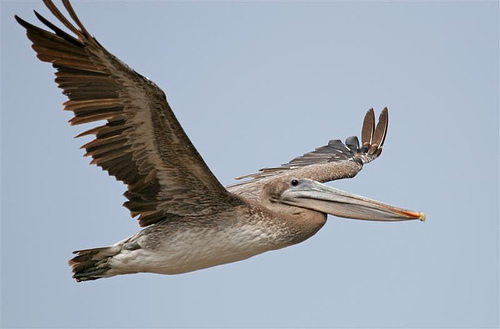This article discusses some of the most interesting brown pelican facts that are rarely available. The Brown Pelican belongs to the family of Pelecanus occidentalisand is considered to be the smallest of all the pelican species. The brown pelican is also the national bird of Barbados. These birds are easily identified by their physical appearance and long bill. These species are also known as American Brown Pelicans.
You can easily recognize these brown pelicans from American White Pelicans through its non-white plumage and also the diving style that these birds have been inherited. When they hunt fish, brown pelicans dive with a great speed which sometimes makes it completely submerged in water.
Brown Pelican Facts
- The length of the brown pelican measures around 106 – 137 cm (42 – 54 inches).
- These species weigh around 2.75 – 5.5 kg (6.1 – 12 lb).
- The wingspan of these types of pelicans is 1.83 – 2.5 metres (6.0 – 8.2 feet).
- They have grayish long bill, with a white head, pale yellow eyes coupled with almost black breast gives it at a completely unique look.
- With exceptional eyesight, these pelicans can view almost every small fish at the water surface. Normally they fly 60 – 70 feet above water.
- The chicks begin their first flight after 75 days.
- These birds are excellent swimmers.

Facts about Brown Pelican Habitat
- These birds mainly reside in the Atlantic and Gulf Coast, Venezuela, Amazon River, Pacific Ocean, British Columbia, Chile, Texas, Mississippi, and Galapagos Islands.
- The females feed their chicks 150 lbs of fish for about 10 – 12 months. They build nests in colonies.
Brown Pelican Facts about its Diet
These kinds of birds largely feed on fish, amphibians, and crustaceans. They usually flow at a low altitude, normally just above the water. These birds also eat Menhaden that covers more than 90% of their diet. Besides, brown pelicans feed on minnows, pigfish, herring, sheepshead, silversides, pinfish, mullet, grass, and prawns. They also rely on anchovies and sardines as their diet.(1)
Brown Pelicans Reproduction Facts
- The nesting period ranges from March to April. They build nests in trees and bushes.
- The materials used for constructing nest include grass, weeds, and grass.
- The nests are at least 5 feet above the ground.
- The females lay 2 – 3 eggs.
- The incubation period lasts for 28 – 30 days.
- The chicks fledge out after 35 days. They remain with their parents for about 63 – 88 days.
- These types of pelicans start breeding after 3 years.
Facts about Brown Pelican Threats
The study of brown pelican facts from the historical point of view show some drastic figures. Back in 1970, the population of these pelicans was dramatically reduced due to several factors. Pesticides were one of them. Local government took serious actions against the usage of DDT so as to ensure the safety of brown pelicans. Brown pelican was also given sheer protection under the Migratory Bird Treaty Act of 1918. Natural disasters had been the biggest threats to brown pelicans. In the late 19th and early 20th centuries, pelicans were hunted for their feathers, which adorned women’s clothing, hats in particular.(1)
Species of Brown Pelican
- P. o. californicus (California Brown Pelican)
- P. o. carolinensis (Eastern Brown Pelican) Gmelin, 1789
- P. o. occidentalis (Caribbean Brown Pelican) Linnaeus, 1766
- P. o. murphy (Pacific Brown Pelican) Wetmore, 1945
- P. o. urinator (Galapagos Brown Pelican) Wetmore, 1945

Leave a Reply